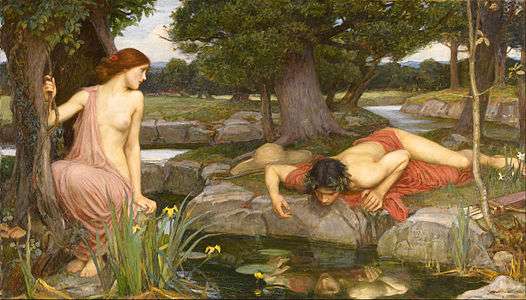Echo and Narcissus (Waterhouse painting)
 | |
| Artist | John William Waterhouse |
|---|---|
| Year | 1903 |
| Medium | Oil on canvas |
| Dimensions | 109.2 cm × 189.2 cm (43 in × 74 in) |
| Location | Walker Art Gallery, Liverpool |
Echo and Narcissus is a painting dating from 1903 by John William Waterhouse. It illustrates the poem Echo and Narcissus from Ovid's Metamorphoses.
John William Waterhouse (1847–1917) was an English painter who, because of his style and themes, has been classified as a Pre-Raphaelite, but is more accurately described as a Neo-Classical painter. He painted over 200 works, mainly in the genres of classical mythology, and of historical or literary subjects. One of his common themes is the femme fatale, the woman who ensnares a man.[1]
Echo and Narcissus is in the genre of classical mythology. In Ovid's version of the myth, Narcissus was the son of the river god Cephissus and the nymph Liriope. His parents were told that he would live to an old age if he did not look at himself. He rejected all the nymphs and women who fell in love with him. One of these was the nymph Echo, who was so upset by her rejection that she withdrew from life and wasted away until all that was left was a whisper. Her prayers were heard by the goddess Nemesis who caused Narcissus to fall in love with his own reflection. He continued to look at his reflection until he died. A narcissus flower grew on the spot where he died.
The painting is in oil on canvas and measures 109.2 centimetres (43 in) by 189.2 centimetres (74 in). It forms part of the Victorian collection in the Walker Art Gallery in Liverpool, Merseyside, England, having been purchased by the museum in 1903.[2]
References
- ↑ John William Waterhouse, jwwaterhouse.com, retrieved 22 April 2010
- ↑ The Walker Art Gallery, London: Scala, 1994, p. 77, ISBN 1-85759-037-6